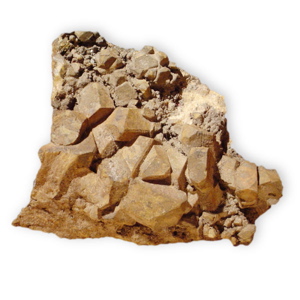
Introducing the most abundant rock-forming mineral:
FELDSPAR
The name, feldspar, comes from Scandinavian words that means "field stone" perhaps because there were so many in the farmers' fields. (The Dynamic Earth.) You can think of feldspar almost like a family of minerals. Feldspars share some common characteristics but they don't all look the same because different feldspars have slightly different chemistry.
Feldspars are composed of:
Oxygen (lots)
Silicon (lots)
plus Potassium and / or Aluminum
Sodium and / or CalciumAppearance:
Individual crystals tend to be opaque, commonly whitish or pink.
Feldspar crystals usually have "faces" meaning sides that look like walls.
Some feldspar crystals have faces at right angles, like most buildings.
Some feldspar crystals have tightly striping.
In sediments, feldspar grains are uncommon. They tend to be blocky and white.
Hardness: 6 to 6.5
A knife blade will not scratch feldspar crystals.How to recognize feldspar crystals in a rock:
What isn't quartz, and what isn't calcite, usually is feldspar.
Look for the faces... the walls. Sun will flash off the faces.Weathering:
Unlike quartz, feldspars are susceptible to chemical weathering. Feldspars do not survive weathering as identifiable mineral grains. The weathering of feldspars to clays causes the slow disintegration of many rocks. The remains of most of the feldspars weathered from the granite in Little Cottonwood Canyon are now clays in Salt Lake Valley.Where you can find feldspar in Salt Lake County:
- As crystals in the igneous rocks of Little Cottonwood Canyon (granites) and igneous rocks of the Oquirrh Mountains.
- In many of the igneous and metamorphic tombstones of local cemeteries.
Other:
Specific feldspars form at specific temperatures and pressures and chemical conditions. Therefore feldspars have the potential to tell detailed stories of their origin: the kind of molten rock, its temperature, its pressures, its water content. The stories tend to be complex, beyond the scope of this course.
